|
Location:
Tula de Allend, Hidalgo, Mexico. |
Grid Reference:
20� N, 99.33� W. |
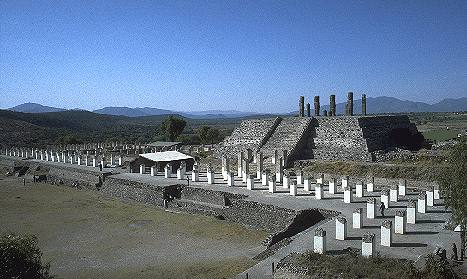
 Tula:
(Toltec Ceremonial Complex).
Tula:
(Toltec Ceremonial Complex).
Tula is generally
accepted as the legendary capital 'Tollan' of the Toltec empire,, founded
around 750 AD, at the same time as the Teotihuacan empire was in decline.
During the height of Tula's
power, between AD 900 and 1100, it included an area of some five
square miles, with an occupation estimated as high as 60,000.
(1)
(Click here for map of the site)
|
Tula: (Tollan,
'Place of the Reeds') |
The centre of the ruined city consists
of a plaza bordered by a lavishly decorated pyramid temple. The site
also contains palace complexes and courts for the ritual ball game
played throughout ancient Central America. In the 11th century, Toltecs
who emigrated from Tula are believed to have settled on the site of the
former Mayan city of
Chich�n Itz� on the Yucat�n
peninsula, where they put up buildings in the Tula style.
The ruins at Tula share many
architectural, artistic and religious influences with the Maya city of
Chich�n Itz�,
some 700 miles away (by land) on Mexico's Yucat�n peninsula. For years,
scholars believed that the warlike Toltec had invaded distant
Chich�n Itz�
and imposed their own culture. Today, however, most archaeologists
believe that Toltec Toll�n was one of many cities with whom the advanced
Chich�n Itz� traded and the common influences flowed from Chich�n Itz�
to Toll�n. Whichever the direction of the cultural flow, there are
several distinct similarities between the two cities.
(More
about Chichen Itza)
|
The Temple of Tlahuizcalpantecuhtli. -
('House of the Morning Star', 'Pyramid B')
The major structure that remains today
from the ruins of Toll�n is the Temple of Tlahuizcalpantecuhtli
(Lord of the House of the Morning Star) � referred to today at the
site with more mundane (and more pronounceable) name of "Pyramid B."
At the top of this pyramid stand four colossal statues, more than 15
feet tall, dressed as warriors. They may represent the Toltec ruler
Ce Acatl Quetzalc�atl (who was named after the fair-skinned god
worshiped by many Mesoamerica cultures). These four figures wear
stylized butterfly breastplates, sun-shaped shields on their backs,
feathered headdresses and carry spear throwers and a supply of
spears. They once served as pillars to support the roof of a temple
that stood atop the pyramid.
Along the base of the pyramid (on the side opposite the stairs) many
Toltec carvings of jaguars, eagles and human skulls are still
visible. At the foot of the stairs is an L-shaped colonnade that
once supported a roof that may have provided a shaded passageway for
the priests and nobility from the main pyramid toward the smaller
Pyramid of the Sun (or "Pyramid C") to the east. Little remains
today of Pyramid C. To the west of the main pyramid is the Quemado
Palace (also known as the "Burnt Palace"), which today is little
more than a foundation that once supported three large rooms and a
forest of truncated pillars that once supported a roof.
The Telamons of Tula: ('Atlantes')
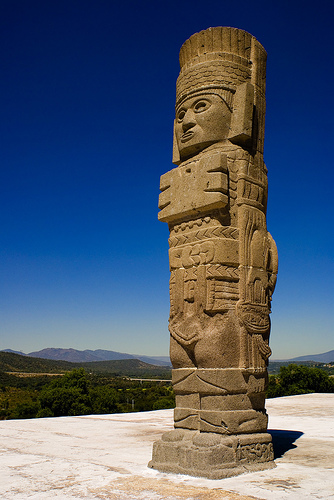 These
four immense statues still stand on the top of pyramid-B. They stand
over 17ft (4.6m) high and are suggested to have once been supports for a
temple. These
four immense statues still stand on the top of pyramid-B. They stand
over 17ft (4.6m) high and are suggested to have once been supports for a
temple.
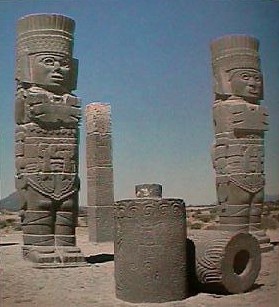
The word 'Telamon' is a generic term
used for any human figure used as a structural support.
Tula's east-facing great
warrior statues, are apparently representations not of Tezcatlipoca, but
of Tlahuizcalpantecuhtli, the Plumed Serpent in his guise as Morning
Star.
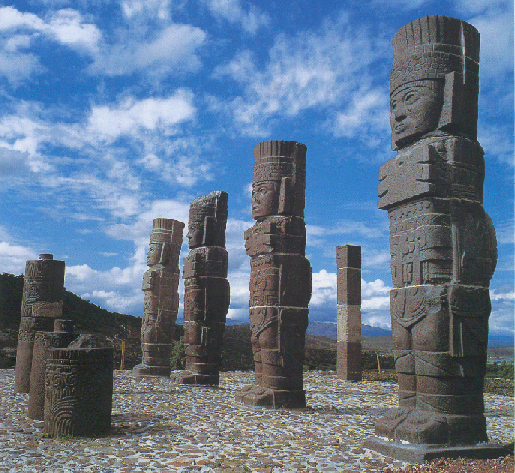
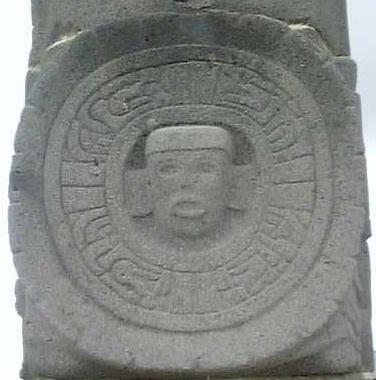
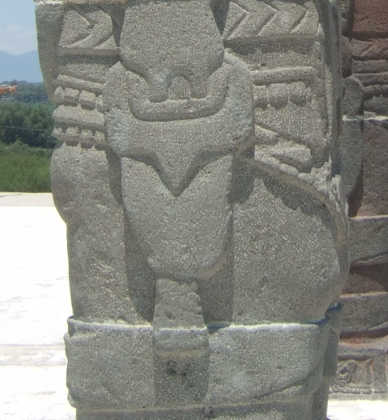
The discs on the backs of the statues (left), and the so called
'Ray-guns' (right). |
The most interesting of the other buildings is
perhaps Coatepantli, or the wall of the snakes, whose name comes from
the reliefs on the north face of the pyramid, which shows snakes eating
human beings. Near, in front of the Palacio Quemado (Burnt Palace), we
find the Chacmool, an inclined statue of a priest on whose chest there
is a bowl where they deposited the offerings to the gods.
|
Chacmool's:
There were once seven Chacmool
at Tula, with only one remaining complete today..
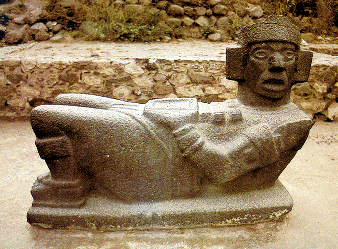
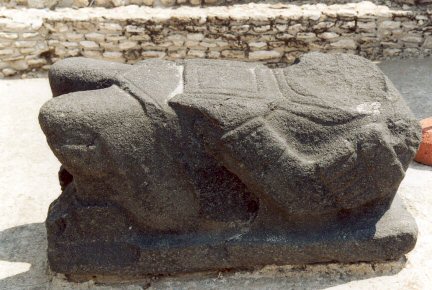
Two Chacmool's in Front Of The Palacio Quemado (Burnt Palace).
Other examples of Chac-mool...
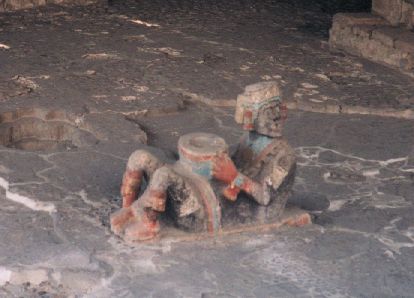
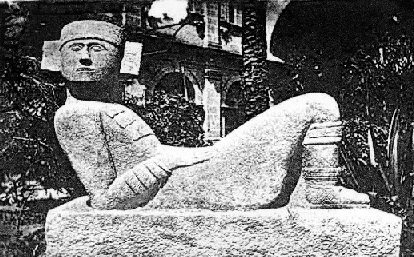
Similar figures have been found at other south American sites such as
Teotihuacan (left), and
Chitzen Itza (right)
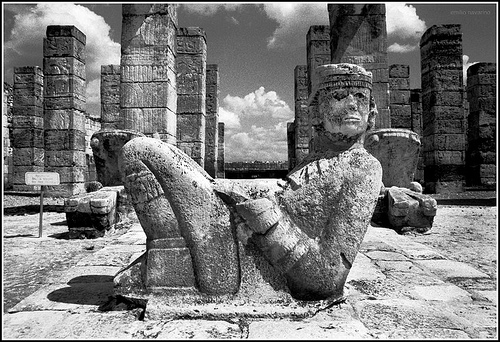
Chacmool at Chitzen Itza.
|
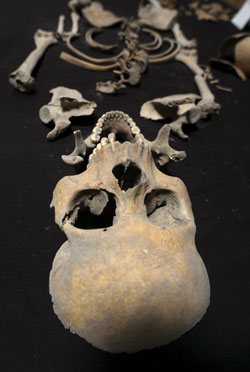
Article: April 2009 - 'Bones of children are displayed in Tula,
Mexico'.
Bones of children are displayed in Tula, Mexico April
19, 2007. The grisly find of the buried bones of 24 pre-Hispanic Mexican
children may be the first evidence that the ancient Toltec civilization
sacrificed children, an archeologist studying the remains said on
Monday. The bones, dating from 950 AD to 1150 AD and dug up at the
Toltecs' former capital Tula, north of present day Mexico City,
indicated the children had been decapitated in a group.
(Click here for full Article)
Gallery of Images.
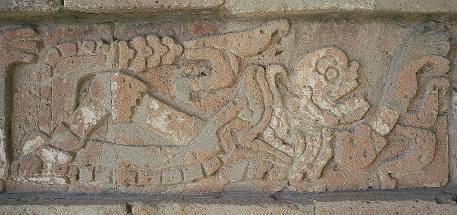
Skeleton being eaten by snake.
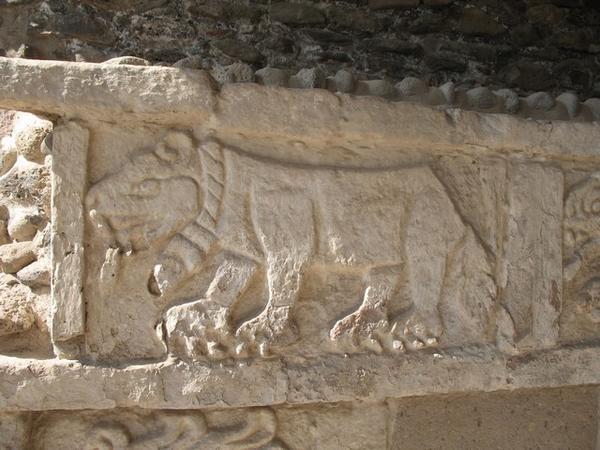
Carved captive Jaguar at Tula.
(Other
Mexican sites)
|